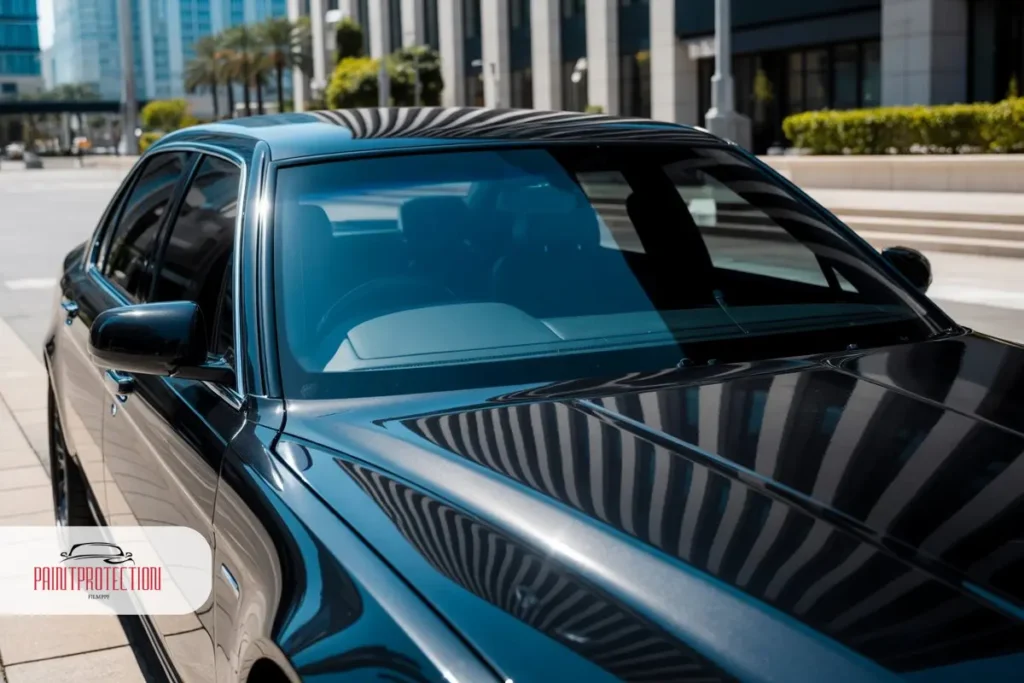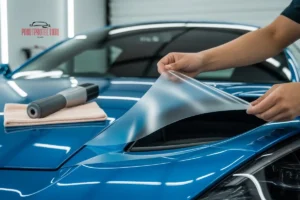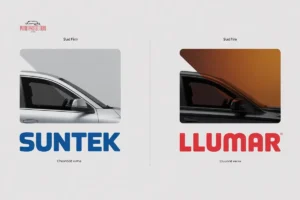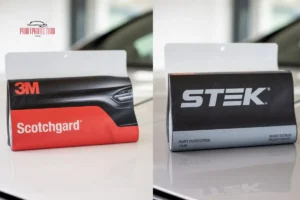If you’re searching for car window tint, you’ve come to the right place. Tinting car windows not only enhances the appearance of your vehicle but also provides privacy, protects from UV rays, & keeps your car interior cooler. Whether you’re exploring car window tint near me services or looking to learn how to tint car windows yourself, PaintProtectionFilmPPF offers expert guidance for a flawless, long-lasting finish. In this guide, we’ll cover the benefits of tinted car window films, types of tint, legal regulations in the USA, and tips for choosing the right installer for your vehicle.
Everything You Need to Know About Car Window Tint
What Is Car Window Tint?
Car window tint is a thin, protective film applied to your vehicle’s windows to reduce sunlight, UV rays, & heat. This film improves privacy, enhances the look of your car, & protects interiors from fading. With tinted car window films, you can enjoy a cooler ride while keeping harmful rays out.
Benefits of Car Window Tint
Installing car window tint offers several advantages:
- UV Protection: Blocks up to 99% of harmful UV rays, reducing skin & interior damage.
- Heat Reduction: Keeps the interior cooler, especially during hot summers.
- Privacy & Security: Darkened windows provide privacy & make valuables less visible.
- Enhanced Style: Gives your car a sleek, modern appearance.
- Glare Reduction: Reduces glare from sunlight & headlights for safer driving.
Types of Car Window Tint
There are several types of tinting car windows films:
- Dyed Window Tint: Affordable, blocks sunlight & adds privacy.
- Metallic Tint: Reflects heat & UV rays, but may interfere with electronics.
- Ceramic Tint: Premium option, excellent heat & UV rejection without signal interference.
- Carbon Tint: Offers a matte finish, blocks heat & keeps clarity intact.
Car Window Tint Laws & Regulations in the USA
Understanding Tint Laws by State
Before installing car window tint, it’s essential to know the legal limits in your state. Each state has specific rules regarding how dark or reflective tinted car window films can be. Failing to comply can lead to fines or having to remove the tint entirely.
Visible Light Transmission (VLT) Percentages
Tint darkness is measured by Visible Light Transmission (VLT), which indicates how much light passes through the windows:
- Front Side Windows: Most states require 35-70% VLT.
- Rear Side Windows: Usually darker tints allowed (often 15-50% VLT).
- Rear Window: Darker tints permitted, some states allow up to 5% VLT.
Additional Legal Considerations
- Windshield Tint: Typically only a strip along the top is allowed.
- Reflective Tint: Some states restrict mirrors-like reflective tints.
- Medical Exemptions: Certain conditions may allow darker tints with proper documentation.
Following these rules ensures your car window tint installation is both safe & legal across the USA.
How to Choose the Right Car Window Tint & Installation Tips
Factors to Consider When Choosing Car Window Tint
Selecting the right car window tint is crucial for performance & appearance. Consider these factors:
- Type of Tint: Choose from dyed, metallic, ceramic, or carbon films depending on your budget & needs.
- VLT Percentage: Make sure it complies with your state’s legal limits.
- UV Protection Level: Higher UV protection helps preserve your skin & car interior.
- Durability: Premium tints last longer & resist bubbling or fading.
- Warranty: Look for installers that provide a warranty for tinted car window films.
DIY vs Professional Installation
- DIY Installation: You can learn how to tint car windows using kits, but it requires patience & precision to avoid bubbles & uneven application.
- Professional Installation: Hiring experts ensures a flawless finish, proper adhesion, & compliance with state laws.
Step-by-Step Tinting Process
Whether DIY or professional, the basic tinting car windows steps are:
- Clean the Window Thoroughly: Remove dirt & grease.
- Measure & Cut Film: Ensure accurate fit for each window.
- Apply Film with Solution: Use a soapy water solution to allow adjustments.
- Remove Air Bubbles: Use a squeegee for a smooth, even finish.
- Trim Excess & Let Dry: Allow the tinted car window to cure completely for several days.
Maintenance Tips for Tinted Car Windows
- Avoid using ammonia-based cleaners.
- Be gentle with the film during washing.
- Regularly inspect for lifting edges or bubbles.
Car Window Tint Cost & Factors Affecting Pricing
Average Cost of Car Window Tint
The price of car window tint in the USA varies depending on the type of film, vehicle size, & installation method:
- Standard Dyed Tint: $100 – $250 for a full vehicle.
- Metallic Tint: $150 – $300.
- Ceramic Tint: $250 – $600 for high-quality films.
- Carbon Tint: $200 – $500 depending on brand & coverage.
Factors That Affect Car Window Tint Prices
Several elements can influence the final cost of tinting car windows:
- Vehicle Size & Type: Larger cars & SUVs require more film.
- Tint Type: Premium films like ceramic & carbon are more expensive.
- Installer Expertise: Professional installation costs more but ensures durability.
- Number of Windows: Full car vs partial tint affects pricing.
- Warranty & Brand: High-quality brands with long warranties can increase costs.
Cost Comparison: DIY vs Professional Installation
- DIY Kits: $30 – $100, but risk of mistakes & bubbles.
- Professional Installation: $150 – $600 depending on film type & quality, ensures flawless results & warranty protection.
Investing in quality car window tint is worthwhile for long-term benefits such as heat reduction, UV protection, & enhanced vehicle style.
Common Myths & FAQs About Car Window Tint

Common Myths About Car Window Tint
Myth 1: Darker Tint Means Better Protection
- Not always. The type of film (ceramic, carbon, metallic) matters more than darkness for UV & heat protection.
Myth 2: All Tints Look the Same
- Films vary in clarity, reflectiveness, & style. Tinted car window films can enhance your car’s look without appearing too dark.
Myth 3: DIY Tinting Is as Good as Professional
- DIY kits save money but are prone to bubbles, peeling, & uneven application. Professional installation ensures a perfect finish.
Myth 4: Tinting Car Windows Is Illegal Everywhere
- Tint laws differ by state. Knowing your local regulations ensures compliance & avoids fines.
How to Find “Car Window Tint Near Me” & Choose the Right Installer
Searching for Car Window Tint Near You
If you’re looking for car window tint near me, follow these tips:
- Online Search & Reviews: Check Google Maps, Yelp, & social media for nearby tinting services with high ratings.
- Local Recommendations: Ask friends or car enthusiasts for trusted installers.
- Compare Services: Look at the types of tinted car window films offered, warranties, & pricing.
Choosing the Right Installer
A skilled installer ensures a smooth finish & long-lasting results:
- Experience & Expertise: Choose professionals with years of experience in tinting car windows.
- High-Quality Films: Make sure they use premium films like ceramic or carbon.
- Warranty & Aftercare: Reliable installers provide a warranty & post-installation guidance.
- Portfolio: Ask to see previous work to check the quality of tinted car window applications.
Questions to Ask Your Installer
- What types of films do you recommend for my vehicle?
- How long will the installation take?
- Do you offer a warranty for your work?
- Are your films compliant with local tint laws?
Finding the right installer ensures your car window tint looks great, lasts longer, & remains fully legal.
Tips for Maintaining Tinted Car Windows
Cleaning Your Tinted Car Windows
Proper cleaning ensures your car window tint lasts longer:
- Use a soft microfiber cloth to avoid scratches.
- Avoid ammonia-based or harsh chemical cleaners; opt for mild soap & water.
- Clean both interior & exterior surfaces gently.
Avoiding Damage to Tinted Windows
- Do not roll down windows immediately after installation; let the tint cure.
- Avoid abrasive scrubbing, stickers, or decals on tinted surfaces.
- Be cautious when using automatic car washes with brushes that can scratch the film.
Regular Inspections & Repairs
- Check for bubbling, peeling, or discoloration periodically.
- Address minor issues early to prevent permanent damage.
- Professional repair can restore your tinted car window without full replacement.
Benefits of Proper Maintenance
- Maintains optimal UV & heat protection.
- Preserves the sleek appearance of your car window tint.
- Extends the life of the film, saving money on premature replacements.
Final Thought
Investing in car window tint is more than just a style upgrade—it’s a practical choice for privacy, UV protection, heat reduction, & overall vehicle longevity. Whether you’re exploring car window tint near me options or learning how to tint car windows yourself, following the right steps ensures a flawless, long-lasting result. Remember to choose the right type of film, comply with state laws, & maintain your tinted car window properly to enjoy all the benefits.
For expert guidance, premium films, & professional installation tips, PaintProtectionFilmPPF is your trusted source for everything related to car window tint. Enhance your vehicle’s look & protection today with PaintProtectionFilmPPF.
FAQs
Q1: How is car window tint installed?
Car window tint is installed by cleaning the glass, cutting the film to size, applying it with a solution, & smoothing out bubbles with a squeegee.
Q2: How much is car tint installation?
Professional car tint installation typically costs $150–$600 depending on film type, vehicle size, & quality.
Q3: What is the best way to tint car windows?
The best way is professional installation using high-quality films like ceramic or carbon for durability, UV protection, & a flawless finish.
Q4: How are car window tints applied?
Tints are applied by cleaning the window, spraying a soapy solution, placing the film, removing air bubbles, & trimming excess for a smooth fit.
Q5: How to properly apply tint?
Proper application involves precise measurement, clean glass, careful positioning, bubble removal, & allowing the film to cure for several days.





